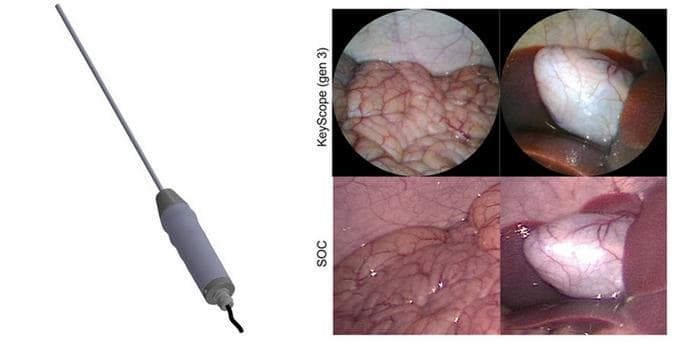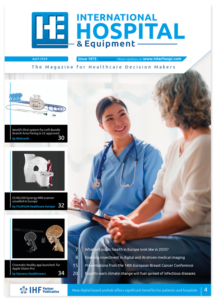Low-cost laparoscope brings minimally invasive surgery to developing nations
Scientists have developed an innovative low-cost laparoscope that could dramatically increase access to minimally invasive surgery in developing nations. The device, called KeyScope, delivers comparable imaging performance to standard hospital systems but costs just $1,000 compared to over $130,000 for conventional equipment.

Low-cost laparoscope, called the KeyScope (left; computer-aided design rendering) enables high resolution surgical imaging with a wide field of view, color accuracy, and low distortion, resulting in comparable images to a standard (SOC) laparoscopic device (right; comparison). © Barnes et al., doi 10.1117/1.BIOS.2.2.022302.
The breakthrough device, detailed in Biophotonics Discovery, replaces expensive fibre optics and fragile lens systems with LEDs and a small camera positioned at the device tip. This radical redesign maintains surgical imaging quality while dramatically reducing costs.
“By addressing the specific needs and constraints of low- and middle-income countries, this innovative device has the potential to improve surgical outcomes and save lives in regions where advanced medical equipment is often scarce,” note the researchers in their paper.
Key technical advantages include the device’s ability to operate via USB power from a laptop, crucial for regions with unreliable electricity. Its waterproof design allows for submersion sterilisation – the common practice in many developing nations where advanced sterilisation equipment is unavailable.
Performance matches hospital standards
Rigorous testing demonstrated the KeyScope matches or exceeds standard laparoscope performance across key metrics. The latest version achieves superior resolution (86.46 μm versus 108.93 μm), lower image distortion, and improved colour accuracy compared to conventional systems.
The authors report the device “has comparable or better resolving power, lens distortion, field of view, depth of field, and colour reproduction accuracy to a standard-of-care laparoscope at working distances commonly used during laparoscopic surgery (3 to 13 cm).”
Local manufacturing supports sustainability
A significant innovation is the ability to manufacture the KeyScope locally in Uganda, ensuring it can be serviced and distributed within Africa. The researchers worked with local engineers to optimize the assembly process, reducing build time to under an hour.
Safety innovations protect patients
The team addressed crucial safety considerations, including eliminating interference from surgical cautery tools and maintaining safe operating temperatures. The KeyScope runs significantly cooler than conventional scopes (40°C versus up to 100°C), reducing risks of tissue burns.
Clinical trials planned
Following successful testing in animal models, the team is pursuing regulatory approval through Uganda’s National Drug Authority. Initial human trials will evaluate the device for cancer biopsies at the Uganda Cancer Institute.
The researchers conclude that through iterative human-centred design involving surgeons and engineers in Uganda, they have created a device that “has been uniquely designed to enable laparoscopic surgery in low- and middle-income countries, which could have beneficial outcomes for many patients.”
Reference:
Barnes, A. C., Kaluzienski, M. L., Chen, J., et. al. (2025). Improved performance and design of a low-cost laparoscope to enable laparoscopic surgery in low-income countries. Biophotonics Discovery, 2(2). https://doi.org/10.1117/1.BIOS.2.2.022302

